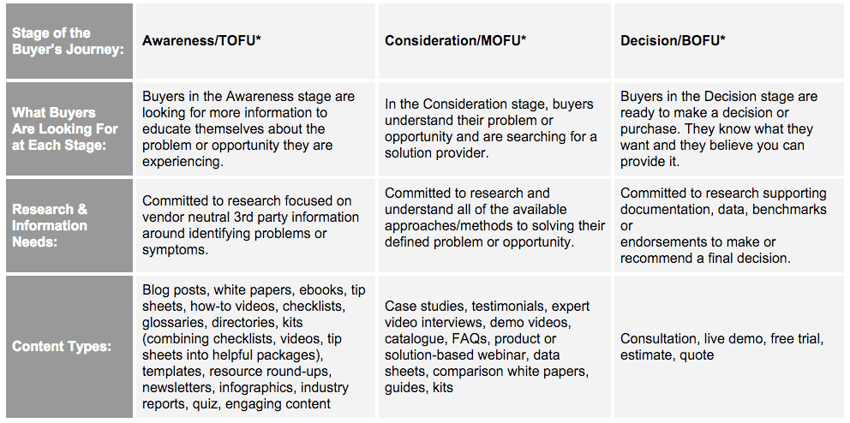How to Map Content to the Buyer's Journey
A lot of companies start creating content and find their investment is like throwing money into a black hole. They create and create and create and nothing happens. So what’s the difference between these companies and the companies that are really successful? Two things:
- They understand their target audience, or buyer personas, to a maniacal extent
- They map the content they create to their buyer persona’s journey to purchase
So, if you’re just getting started with content marketing and want to do it really well, you should start by doing some in-depth buyer persona research. Figure out who your personas are and then pick one to focus on. By dialing in on one persona’s interests, challenges, and behaviors, you can create more targeted content faster and generate results far more quickly and inexpensively than if you try to reach all your personas.
Most articles and templates for creating buyer personas will tell you to research and understand each persona’s demographics, their job role, what a day in their life looks like, what skills they have, what knowledge and tools they use, what their team looks like, their biggest challenges, what success looks like to them, etc. All of this information is tremendously useful for creating content that truly speaks to each persona but there’s one more piece we add that helps us create content that matches their journey to purchase.
When researching our primary persona, we always figure out what questions they are asking in each step of their mental journey to purchase.
To do this, you first have to define each step in the process. Here’s how we define each:

*TOFU, MOFU, and BOFU refer to the classic sales and marketing funnel metaphor.
TOFU=Top of funnel or awareness-stage visitors
MOFU=Middle of funnel or consideration-stage visitors
BOFU=Bottom of funnel or decision-stage visitors
Then, we make a list of questions our persona is likely to ask in each stage. Ideally, we interview a number of individuals who fit our persona’s description to add to this list.
For example, if I’m a car dealership, the questions my persona is asking might look like this:
Awareness Stage | TOFU Phase
The persona is experiencing a problem and is starting to research it.
- How much does it cost to fix a broken transmission?
- Is it easy to get a car seat in and out of my car?
- How can I get better gas mileage?
- How can I get my car ready for a road trip?
- How can I save on auto repairs?
- Should I purchase snow tires?
Consideration Stage | MOFU Phase
The persona is seeking a solution to their problem
- What makes a vehicle safe for car seats?
- What cars have the highest safety rating?
- What vehicles are best on winter roads?
- What vehicles are the lowest cost to own?
- What are the best road trip vehicles?
- Will it cost more for me to repair my vehicle or buy a new one?
Decision Stage | BOFU Phase
The persona is ready to make a decision.
- What deals/promotions can I take advantage of?
- Which car is better for kids, this one or that one?
- What do I need to know about the vehicle’s history?
- How does this car navigate the snow?
- Can I get this vehicle in a different color?
- What is the warranty on this vehicle?
Once you understand the questions buyer personas are asking in each phase of their journey, you can develop content that meets their needs throughout. For example:
Awareness Stag content:
- Blog post on the pros and cons of buying snow tires
- Video shared on blog and social media with road trip tips
- Cost comparison infographic on auto repair solutions
- Blog post on everything expectant parents need to know about car seats
Consideration Stage content:
- Video walking through car features that make taking a car seat in and out as quick and easy as possible
- Downloadable report on the safest cars of the year
- Downloadable chart comparing the cost to own various vehicles
- Interactive tool that estimates the cost of repairing a vehicle vs purchasing a new one
Decision Stage content:
- Phone or in-person consultation with knowledgeable sales staff
After we map the content and create it, we create conversion pathways to nurture awareness-stage visitors down our sales funnel to become customers. Typically, we do this by requesting their contact information in the awareness or consideration stage (usually via a web form) and sending them email sequences that give them tips/insight and ask them to take the next step.
Developing a content plan that meets your key persona’s needs throughout their journey establishes you as a thought leader and credible source of information, builds trust with your brand, and nudges them closer to purchase in a way that feels helpful and not just sales-y.
After you’ve created TOFU, MOFU, and BOFU content, and the email workflows needed for nurturing, you can use analytics to monitor visitors’ behavior has they move down the funnel. Watch for points of friction where people start to abandon your content and make changes or develop new content to fill the gaps. Before long, you’ll have an automated content marketing and sales engine driving plentiful leads and sales for your business like a 24/7/365 salesperson.

